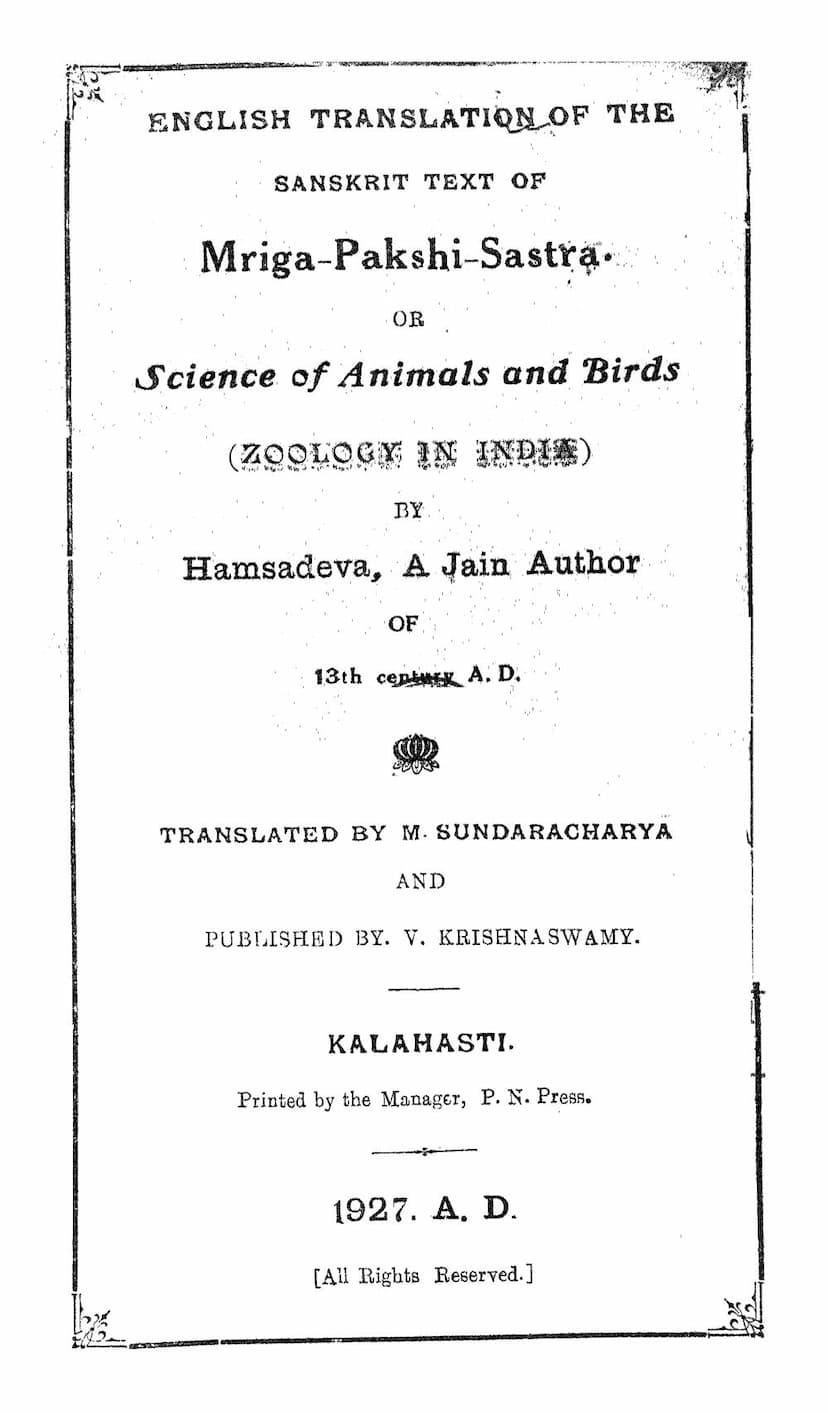Mriga Pakshi Shastra
Added to library: September 2, 2025

Summary
Here's a comprehensive summary of the Jain text "Mriga Pakshi Sastra" by Hamsadeva, based on the provided PDF:
Title: Mriga Pakshi Sastra (Science of Animals and Birds)
Author: Hamsadeva (Jain author of the 13th century AD)
Translator: M. Sundaracharya
Publisher: V. Krishnaswamy
Overview:
"Mriga Pakshi Sastra," translated as "Science of Animals and Birds," is a significant work of ancient Indian zoology. Composed in Sanskrit by the Jain author Hamsadeva in the 13th century AD, it comprises approximately 1700 slokas (verses) in the Anushtup meter. The text is notable for its comprehensive description of various animals and birds, encompassing their physical characteristics, temperaments, life spans, reproductive cycles, and even specific varieties. This work predates extensive zoological studies in India, with earlier mentions like Varahamihira's being much briefer. The translation aims to present the original essence in simple language, without relying on modern Western or Indian naturalists' works.
Key Contributions and Features:
- Early Comprehensive Zoology: The book is recognized as one of the earliest and most extensive works on zoology in India, providing detailed information that was unprecedented for its time.
- Age Limits for Animals and Birds: A notable contribution highlighted is Hamsadeva's provision of specific age limits for a wide range of animals and birds, even for smaller species like hens.
- Classification based on Gunas (Qualities): The text categorizes animals and birds based on the three gunas of Jain philosophy:
- Satwa-guna: Qualities of excellence or goodness.
- Raja-guna: Qualities of much passion and pride.
- Tama-guna: Qualities of mental darkness. These are further subdivided into Uttama (Superior), Madhyama (Middle), and Adhama (Inferior) within the Raja and Tama classifications.
- Detailed Descriptions of Species: The book meticulously describes numerous animals and birds, dividing them into 36 groups. For each group, it provides a general description followed by detailed descriptions of specific varieties.
- Mammals Covered: Lions, Tigers, Hyenas, Bears, Rhinoceroses, Elephants, Horses, Camels, Asses, Boars (including wild boars), Buffaloes, Bullocks, Cows, Goats (including Sheep), Deer (including Musk Deer), Sabaries, Monkeys, Jackals, Cats (including Civet Cats), Rats, Hares, Wolves, Dogs.
- Birds Covered: Swans, Ruddy-geese, Sarasa birds, Balaka birds, Chakora birds, Sarari birds, Chataka birds, Garuda birds (and Hawks), Eagles, Cranes, Kahwa birds, Crows, Owls (including Kausika birds), Parrots, Cuckoos, Peacocks, Pigeons, Blue-jays, Cocks, Chataka/Sparrows, Karetu birds, Heron, Darvaghata birds, Wagtails, Skylarks, Kalinga birds, Plava birds, Tittiri birds, Kukkubha birds, Lava birds, Koyashti birds, Harita birds.
- Parameters of Description: For each animal and bird, the text typically details:
- General description
- Time of intercourse and pregnancy
- Early stages and varieties
- Number of kinds, colors, and specific work/functions
- Nature of females
- Limit of age
- Quality (ferocious, calm, or dull)
- Main food
- Temperament (cruel, hot, mild, dull, calm)
- Author's Introduction and Narrative: The author's introduction sets the context, describing how King Saudadeva, a Jain ruler, initiated this work. King Saudadeva, after witnessing the beauty of animals in a forest and realizing the potential loss if they were all hunted, requested scholars to describe them. This led to Hamsadeva's extensive treatise.
- Tables and Indices: The work includes valuable tables:
- Table No. 1: Classification based on gunas (Satwa, Raja, Tama).
- Table No. 2: Utmost age of animals and birds.
- Table No. 3: Temper and nature of animals and birds.
- Table No. 4: Sanskrit proper names of animals and birds with their varieties and page references.
- Table No. 5: English proper names of animals and birds with their group and page references.
- Table No. 6: Contents, listing groups, animals/birds, and corresponding sloka and page numbers.
- Statistical Table: Summarizes key information like the number of varieties, main colors, period of youth, time of full passion, pregnancy period, delivery time, temperament, utmost age, and main food for many animals and birds.
Significance and Preservation:
The preface highlights that the original manuscript was on the verge of disappearing but was saved by Pandit Sreeman Vijayaraghavachariar, who facilitated its translation and publication. Copies were also supplied to institutions like the State Museum of Travancore and McGill University.
In essence, "Mriga Pakshi Sastra" is a monumental Jain contribution to the field of zoology in ancient India, offering a detailed, systematic, and insightful exploration of the animal and bird kingdom, rooted in the philosophical framework of Jainism.